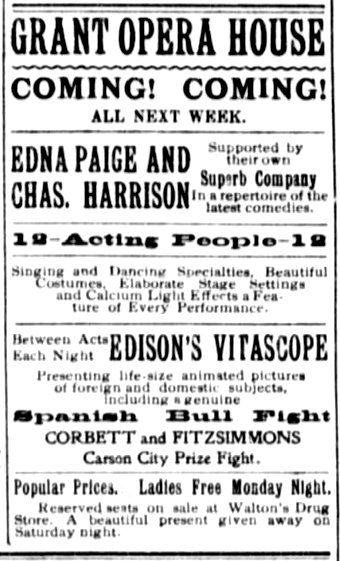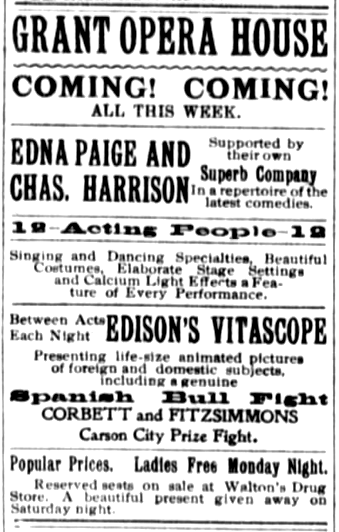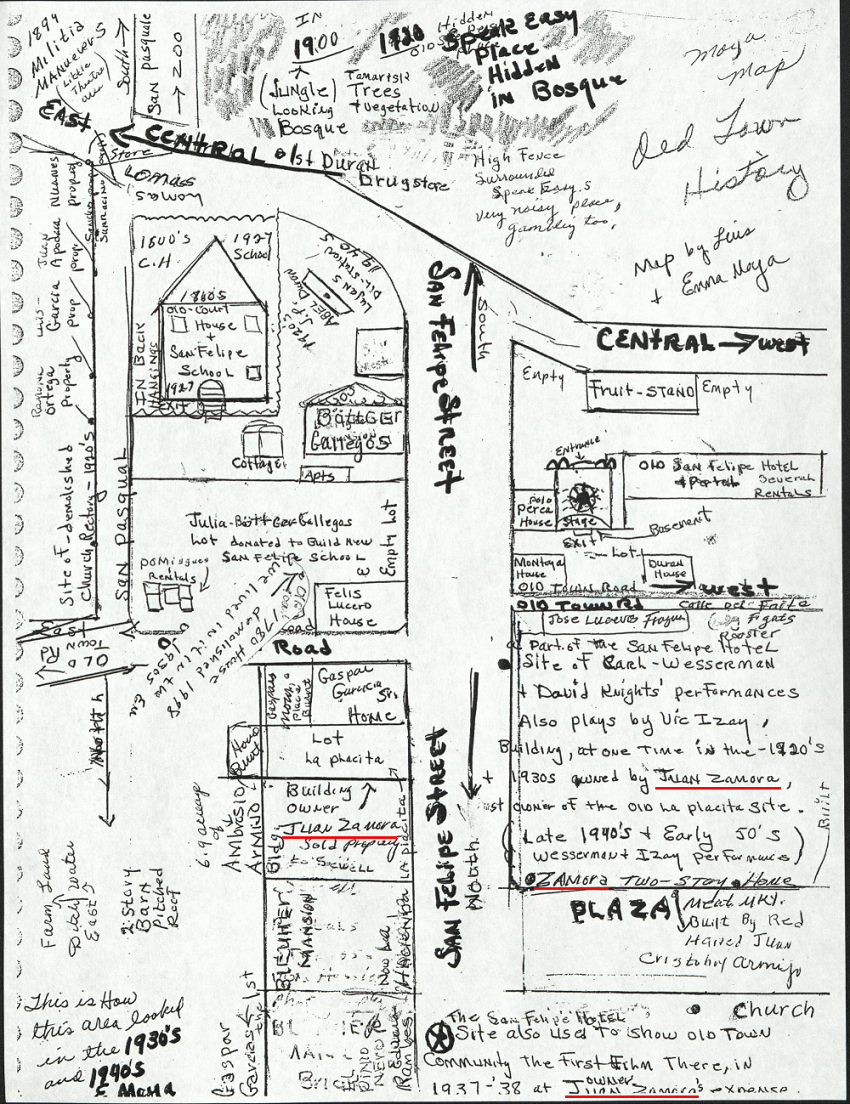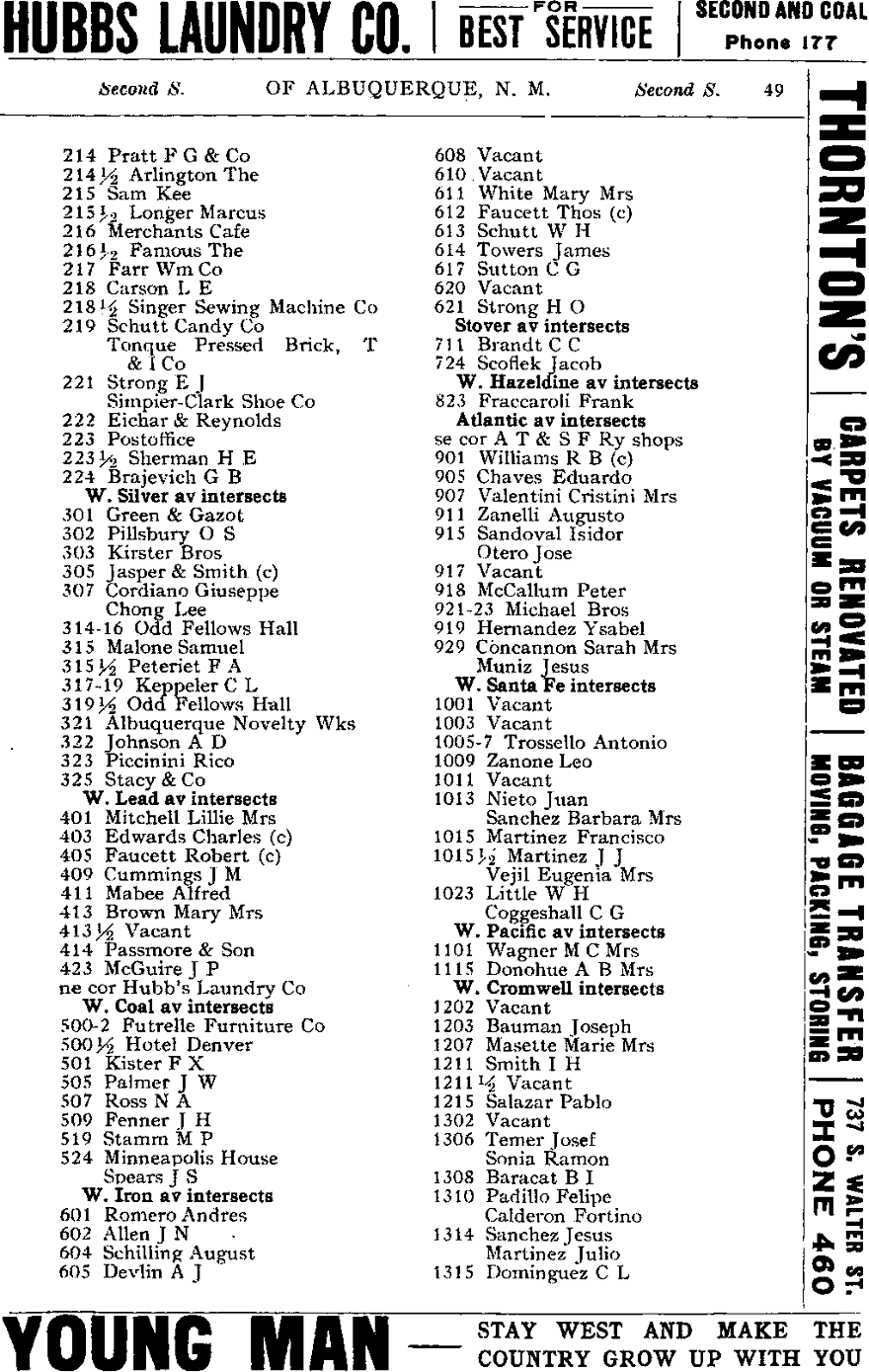Chapter 51
Albuquerque’s Forgotten Cinemas
Albuquerque’s Forgotten Cinemas
OKAY, YOU LOOKED, DIDN’T YOU?
You looked up these cinemas on
CinemaTreasures.org, didn’t you?
You’re suspicious of my stories, aren’t you?
You cannot find Donald Pancho’s or the Roxy or the Screening Room/Galería.
That’s right.
There are no entries for Donald Pancho’s or the Roxy or the Screening Room/Galería on CinemaTreasures.org.
I don’t know why there aren’t, but there aren’t.
That does not mean I’m making things up, though.
You can find references to all those cinemas by searching through old Albuquerque phone directories and city directories and newspapers.
If you do that, you will discover that CinemaTreasures.org makes no mention of numerous other cinemas as well:
NAME AND LOCATION |
DATES MOVIES WERE SHOWN | ||||
|
Angus Archibald GRANT’S
OPERA HOUSE 301 Railroad [Central] Ave NW (Legit house. Opened 20 Nov 1883. Burned down 18 Jun 1898.) |
03 Feb 1898 – 03 Jun 1898 | ||||
|
ORCHESTRION HALL (aka Exhibit Hall, or Amusement Hall) Territorial Fair Grounds, sw of Old Town Plaza |
12 Jun 1898 – 28 Jan 1899 | ||||
|
NEW PAVILION THEATRE 215 Railroad [Central] Ave NW (In 1898 a shop stood on this site. In 1902 a different shop stood on this site.) |
03 Jun 1901 – 09 Jun 1901 | ||||
|
ARMIJO HALL 304 Railroad [Central] Ave SW (On the site of the previous Mariano Armijo House, which had been built in 1880 and which burned down on 10 Feb 1897.) |
15 Dec 1902 – 25 Dec 1902 | ||||
|
COLOMBO THEATRE (formerly & subsequently Columbus Hall) 416 2nd St NW |
08 Jan 1903 – 20 Sep 1909 | ||||
|
(first)
CRYSTAL THEATRE 402 2nd St SW, se cor Lead Ave SW (Open-air; tent?) (Do not confuse with the 2nd Crystal at 120 W Gold Ave or with the 3rd Crystal at 219 S 2nd St.) |
01 Aug 1907 – 14 Sep 1907 | ||||
|
(second)
CRYSTAL THEATRE 120 Gold Ave SW (Do not confuse with the 1st Crystal at 2nd/Lead or with the 3rd Crystal at 219 S 2nd) |
16 Sep 1907 – 07 Oct 1911 | ||||
|
AIRDOME THEATER 402 2nd St SW, se cor Lead Ave SW (Open-air; tent? Same as the 1st Crystal?) |
18 May 1908 – 30 Jun 1908 | ||||
|
ELKS’ OPERA HOUSE
(aka
Elks’ Theatre) 502 Gold Ave SW (Opened 29 Feb 1904. Final scheduled theatrical 25 Sep 1914. Final scheduled use of the theatre 30 Oct 1914. Surprise booking on 12 Nov 1914. Theatre portion remodeled into a gymnasium in Dec 1914. Building burned down on 01 Jun 1920. Later rebuilt as a clubhouse, minus the theatre.) (Links: 23 Jan 1909, 01 Sep 1914, 16 Sep 1914, 22 Sep 1914, 31 Oct 1914, 31 Oct 1914, 01 Nov 1914.) |
23 Jan 1909 – 16 Feb 1909 | ||||
|
Juan R.
ZAMORA’S THEATER #1 716 [now 208] San Felipe St NW (Never advertised; previously a hall; later a dance hall. Currently Grandfather Eagle Custom Jewelry.) (Links: 06 Mar 1910, 13 Feb 1911, 15 Apr 1922, 18 Jun 1938, 03 May 1940, 02 Jul 1940, 20 Nov 1958, Grandfather Eagle.) |
ca. 1909 – ca. 1913 | ||||
|
Juan R.
ZAMORA’S THEATER # 2 1408 2nd St SW (Never advertised.) |
ca. 1909 – ca. 1913 | ||||
|
THE
AIRDOME 300 2nd St NW, ne cor Tijeras Ave NW (Open-air.) (Links: 22 May 1910, 28 May 1910, 29 May 1910, 30 May 1910, 03 Jun 1910, 03 Jun 1910, 23 Jun 1911, 06 Jul 1910, 12 Jul 1910, 20 Jul 1910, 30 Jul 1910, 02 Oct 1910, 20 Oct 1910, 12 Jul 1915, 15 Jul 1915.) |
27 May 1910 – 18 Jul 1915 | ||||
|
Wm. V. Futrelle’s
ORPHEUM THEATRE 504 2nd St SW (Later a dance hall/ skating rink.) (Links: 22 Oct 1911, 09 Nov 1911, 10 Nov 1911.) |
09 Nov 1911 – 05 Nov 1915 | ||||
|
THE B THEATER 200 Central Ave SW (Links: 16 Sep 1914, 21 Oct 1914.) |
06 Feb 1915 – 30 Apr 1924 | ||||
|
SAN FELIPE THEATRE “2000 Lomas Blvd NW” (in reality 150 San Felipe St NW) (Formerly the Old Town Court House.) (Links: 21 Jun 1929, 23 Jun 1929, 26 Jun 1929, 28 Jun 1929, 25 Sep 1929, 15 Dec 1929.) |
15 Jun 1929 – 29 Jul 1929 | ||||
|
SAVOY 215 1st St SW (Later the Aztec; gutted to become Manhattan Café.) (Links: 10 May 1930, 11 May 1930, 11 May 1930.) |
11 Aug 1929 – 16 May 1930 | ||||
|
LA SANDIA
(Do not confuse with the Sandia.) 1220 3rd St SW |
23 Apr 1937 – ca. 29 Apr 1938 | ||||
|
CORONADO
(Do not confuse with the Coronado 4.) 113 1st St SW |
12 Aug 1938 – 09 Jul 1951 | ||||
|
TREE HOUSE THEATRE (La Mesa Shopping Center) 3117-B San Mateo Blvd NE (This must have been 16mm.) |
19 Dec 1970 – 27 Aug 1971 | ||||
|
CINEMA PETITE (aka Cinema View 1 and Hoffmantown Theatre) 8202 Menaul Blvd NE (Hoffmantown Shopping Center) (Links: 18 Nov 1972, 18 Apr 1973, 19 Apr 1973, 06 Jul 1974, 11 Sep 1974, 31 Jan 1979.) (The screen was 10'×20'? If so, most of it was hidden. The visible portion of the screen was maybe 4'×9' at the very most. The Super Simplex machines were battered nearly beyond repair. The films were out of frame, too. Nobody in the audience could tell the difference. Nobody cared.) | 18 Jul 1971 – 28 Feb 1980 | ||||
It looks fine man! Now get outta here man! |
|||||
|
ENCORE THEATRE
(formerly the Mini Vue) 3211 Central Ave NE |
23 Apr 1975 — 06 Nov 1976 | ||||
|
THE SILVER SCREEN 5600 McLeod Rd NE (16mm. Operated by brothers Mark and Bruce Dowling, Mark’s wife Kathy, and Bruce’s girlfriend Stacy Means.) |
11 Jun 1975 — 13 Dec 1975 | ||||
|
EL CIELO 1810 Central Ave SW (Next door to the former Sandia cinema, 1814 Central.) (Originally, November 1939, this was the Will Rogers Highway Café as Route 66 was then sometimes called the Will Rogers Highway. The Magic Bar relocated here in about 1955 and operated through about 1961, with the bartenders performing magic tricks for their customers. For two months in 1971 it was a porn cinema called the Sidedoor, which in 1976 reopened as the Magic Pyramid.) |
07 Jan 1977 – 01 May 1977 | ||||
|
the miserable
FAR NORTH 6300 San Mateo Blvd NE For some reason not remembered by me, I visited the booth one Saturday afternoon prior to June 1979. All these years, I thought I saw a movie there, but I couldn’t remember which one, which is entirely unlike me. I racked my brain trying to remember which flick I saw there, to no avail. That drove me totally nuts, which is why I just went through all the newspaper advertisements, which took many hours over three days, just to satisfy my frustration, and now I am CERTAIN that I NEVER saw a movie there. Puzzling. Zo, what in the heck was I doing there? Why on earth would I travel that far for no reason? Wait a minute! I remember. As I type this, I remember, it comes back to me, though only vaguely. I needed a job and so filled out an application. When I saw the machines and the brainless teen projectionists, I was appalled, and I was relieved not to have been called back. Really, for more than four decades, I had no recollection of that at all. I needed a memory jog to pull up a vague recall of a momentary encounter with that putrid edifice. Ironically, two decades later, when I was hired by Super Saver, I was appalled all over again to discover that my new employer had just acquired the Far North! Yeah, when the circuit’s tech mentioned that, I blurted out, “The Far North!?!?!?!?” but he did not respond. He had no interest in picking up that conversation. He did not give the impression of being a loquacious connoisseur of scintillating dialogues. |
28 Aug 1977 – 01 Apr 1995 | ||||
|
And while researching the above, what do I discover but that Buster Keaton had a real-estate agency in Albuquerque! 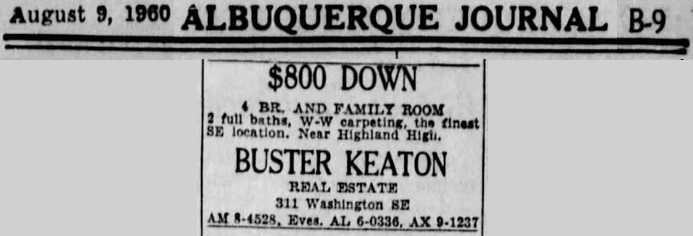 Did you know that? Really. Did you know that? I don’t think you knew that. Alas, this was a different Buster Keaton. I am surprised to learn that around the US were several guys who called themselves Buster Keaton. | |||||
You know what’s odd about Albuquerque, yes? When I lived in Buffalo, I was surprised but delighted that the locals all knew their past. The Sunday antiques fair in neighboring Clarence was a never-fail treasure hunt, for there we could find local items and local ephemera going back to the 1880’s. Ditto in Rochester. You could visit the Yankee Peddler Bookshop and be surrounded by items from Rochester’s past, available for mere pocket change. The situation is entirely different in New Mexico — and in Colorado, and in California, and in Toronto. Antique shops in New Mexico and Colorado and California and Toronto deal only in generic antiques — tables, chairs, chandeliers, and so forth. Ask about locally produced items, and you will be met with a blank stare. Ask about local ephemera prior to the 1960’s, and nobody will know what you’re talking about. That is why it is so bloody impossible to research Albuquerque’s cinema/theatre history. Everything was tossed away as valueless. Blueprints, architects’ renderings, construction notes, business files, receipts, ledger books, insurance photos, programs, schedules, broadsides — nope. All gone. All gone. All gone. Were any of the business owners or staffers interviewed at length about their lives and experiences? Never. Did a single one of them write a memoir? Only Kathryn Kennedy O’Connor, who wrote a book on her Little Theatre. As for all the rest, there is only silence. When I would ask about the old days, I discovered to my dismay that nobody in theatre or cinema knew anything about anything earlier than 1962. Well, Frank Peloso knew a lot about the business history, but his lips were sealed. He knew less than nothing about the technical end, as was painfully apparent when he pretended to. I mean, he owned the Sunshine Theatre, but he didn’t even realize it had a stage behind that screen! I tried countless times to chat with him about the older days, but he simply did not chat with commoners. He took all his unrecorded, untold stories to the grave.
Well, I lied. I found a single image of a single broadside, in the most unlikely place!
It was for the Albuquerque Opera House, Monday, 5 February 1883.
Maddeningly, two and a half lines were sliced out across the middle.
I filled them back in as best I could.
I think I made the right guesses (“THE HAPPY CORK ARTISTS,” “Billy,” “Paul”).
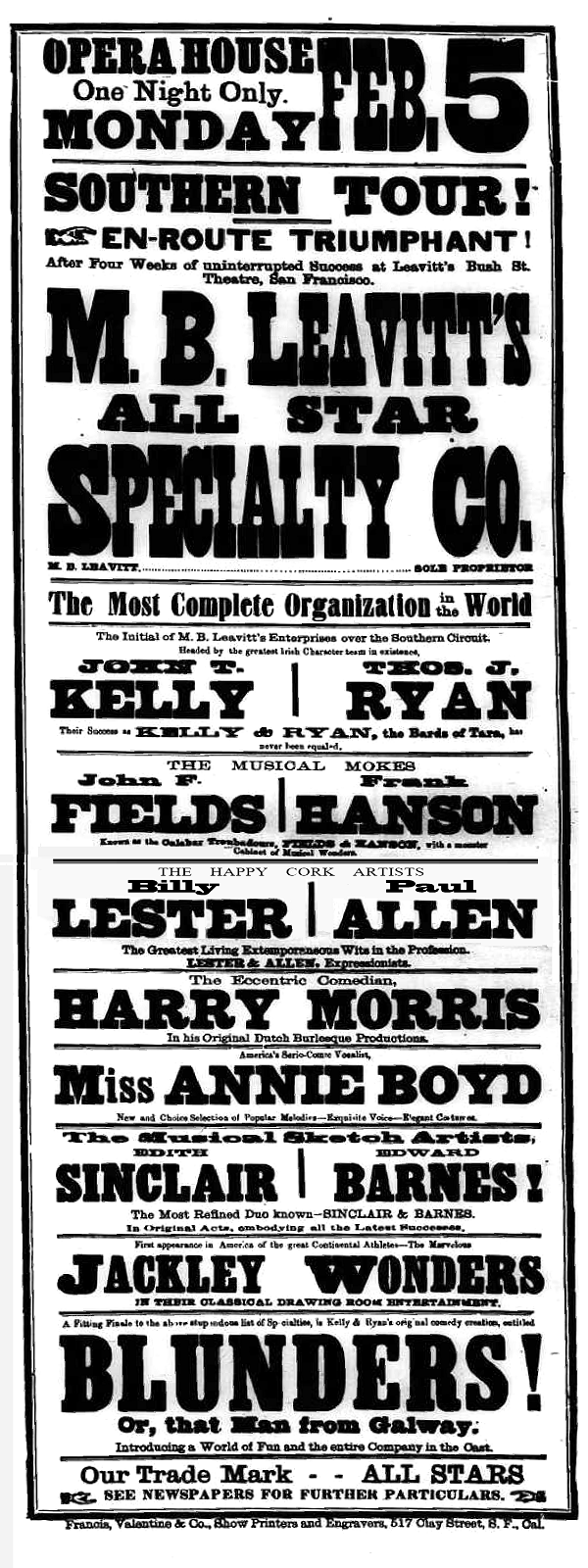
Printed not in Albuquerque on behalf of the Albuquerque Opera House,
but in San Francisco on behalf of the Leavitt stock company and its accompanying unit revue.
In case you want to know:
• Michael B. Leavitt
• John T. Kelly and Thomas J. Ryan
• John F. Fields and Frank Hanson (pp. 250–251, 277)
• Lester & Allen
• Harry Morris
• Annie Boyd
• Edith Sinclair & Edward F. Barnes
• Jackley Wonders
• Blunders; or, That Man from Galway
• Michael B. Leavitt
• John T. Kelly and Thomas J. Ryan
• John F. Fields and Frank Hanson (pp. 250–251, 277)
• Lester & Allen
• Harry Morris
• Annie Boyd
• Edith Sinclair & Edward F. Barnes
• Jackley Wonders
• Blunders; or, That Man from Galway
Albuquerque’s first view of movies was in, oh, I don’t know.
I’m pretty sure it was the Magniscope on Wednesday, 28 April 1897, not long after Edison purloined it from its inventor, Edward Amet.
Then as now, the law was used not to protect creative people, but to crush them.
I’m pretty sure that was Albuquerque’s introduction to the moving picture.
I betcha.
Then, for six days commencing Monday, 25 October 1897, Grant’s Opera House booked Edison’s Triograph,
which, predictably, was actually Lumière’s Model B Cinématographe but with an Edison nameplate.
Here are some interesting items, though from a bit later:
Orchestrion Hall in Old Town showed some movies later that same year, just after Grant’s Opera House burned down.
And don’t forget that the Elks’ Lodge sponsored the
Edison Projectoscope at the September 1900 fair.
The Elks’ Opera House re-introduced Albuquerque to movies on Saturday, 6 January 1906.
By 1909, the Elks’ Opera House was often called the Elks’ Theater
and it briefly presented vaudeville and movie programs, separate from its regular stage shows and concerts.
The Zamora # 1 had long puzzled me.
It took me 45 years to pinpoint it, but I finally succeeded.
It still stands, and it is now Grandfather Eagle Custom Jewelry,
the northernmost shop in Casa de Armijo/La Placita.
It was originally numbered
716 San Felipe, but has been renumbered 208 San Felipe.
I bet that, as a cinema, the Zamora # 1 had a flat floor with folding chairs.
I bet that the projection booth was a portable prefab tin thing atop a wooden scaffold, and that it held a probably a single machine.
I bet that Zamora # 1 served as a dance hall and a general assembly room during non-movie hours.
A rough hand-drawn map, not to scale, indicates several neighboring addresses as Juan Zamora’s in the 1930’s/1940’s:
“Old Town Albuquerque Map Further Debunks the Ghost Story of Scarlett,”
Southwest Ghost Hunter’s Association, 9 April 2017.
The Zamora # 2 now puzzles me.
The City Directory provides the address as 1408 S 2nd St. See?
Until just today, that seemed perfectly straightforward,
but now that the Sanborn Maps are posted online, I decided to locate it and learn something, yet the Sanborn Maps do not detail that address.
The maps, any maps, get mind-bogglingly confusing when it comes to this address.
So let us turn to Worley’s 1909–10 City Directory and go down the list of every edifice on South Second Street. Okay?
Sheesh. So, what does that mean? Let us look at the Sanborn Map index, to see where we can locate this:
Zo, it was on the east side of the street, about half-way between Cromwell and Bridge.
My heavens! That’s next to impossible to locate now with any precision.
Cromwell, Second, and Bridge have all been rerouted.
Unfortunately, Sanborn did not publish a detailed map to that part of town,
and so all we find is in the above index page.
Anyway, Zamora # 2 is definitively gone.
Though we do not know exactly where it was, we know more or less where it was, and
the railyard has now expanded to engulf that spot.
I indicate with a red star surrounded by a red circle my best guess as to where it stood.
I am willing to bet that it was a wood-frame storefront, no larger than a small house, and that it was as plain as could be.
I am almost willing to bet that, like # 1, it had a flat floor, folding chairs, and a single machine
in a prefab tin booth atop a wooden scaffolding.
I am almost willing to bet that it had no interior decoration worth talking about.
I wonder why Judge Zamora adjudged it a good idea to open a cinema/assembly hall out in the middle of nowhere.
As far as I know, the first cinema in Albuquerque built as such was the Pastime, which opened on 1 September 1909.
The Pastime was later
rebuilt as a vaudeville house in 1925.
By
January 1934, it was renamed the Mesa.
After it stopped showing movies, the San Felipe Theater continued presenting the occasional live presentation until sometime in 1932.
This was originally a court house, but was converted to a Jesuit school.
Shows were in the court room/assembly room, but only during non-school hours.
Now on the site is the San Felipe de Neri Parish.
Despite its address as 2000 Lomas, it was actually at about 150 San Felipe Street.
So typical.
As for the short-lived Silver Screen, it projected 16mm movies from a pair of Bell & Howell portable machines,
and, contrary to its name, it projected those movies onto a bedsheet.
In its last few weeks, in a desperate attempt to keep solvent, it switched to hardcore before giving up the ghost.
There were surely other cinemas, too, but they have so far eluded my gaze.
I do not include the New Coliseum Theatre, 7905 Central Ave NE, which opened in about July 1975 with off-beat movies,
simply because it was operated by Madowhy Corp. and quickly switched to hardcore.
We should also bring up the 108-seat
Mini Vue, simply because of an anomaly.
The Mini Vue (opened 31 July 1969 by Pat C. Baca’s brother-in-law, Jay C. Battershell, born circa 1942)
presented strictly “adult” films, a euphemism for porn.
I seldom acknowledge porno houses as cinemas.
Yes, I’m bigoted. So what are you going to do about it, huh?
It is true that the porno movies of 1969 would no longer qualify as porn; they were mostly nudie cuties.
They would now be considered laughably tame, except that they are so excruciatingly dull that it is impossible to laugh at them.
(Exception: the films of the great Russ Meyer. He made only one good movie,
the terrifying Mudhoney,
which played at The Guild under C & D, by the way,
3–13 June 1966,
but even his worst movies are watchable, and, from what I’ve seen so far, most are quite funny.)
Yet the Mini Vue did indeed have a single claim to legitimate cinemahood, as witness below:


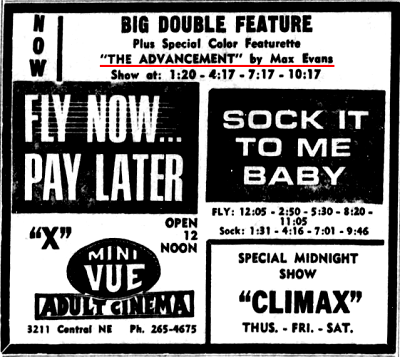
Are you confused yet?
There is no mention of The Advancement on IMDb or anywhere else that I can find.
Why on earth would a movie such as this be premièred at the Mini Vue?
I just looked up Max Evans on Google, and I discovered this on Amazon:
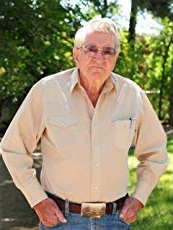 About Max Evans
Max Evans was born on August 29, 1925, in Ropes, Texas, and currently lives with his wife Pat James in Albuquerque, NM.
He is a writer and director, best known for his novel, The Rounders (which was made into a movie starring Glenn Ford and Henry Fonda in 1965)
and The
Evans has published over 25 books and won multiple Spur, Wrangler, and Owen Wister awards. |
The Mini Vue croaked its last after less than six years. A Detroiter who had worked in cinema since 1937, Peter Kavel, revamped the building and converted it into the
I was surprised to learn about this movie, and then I was even more surprised to discover that it’s online!
It is now my new favorite movie.
Concert Hall, or Popejoy Hall as it’s now called, is not a great theatre.
It’s a dull standard 60’s design, but the structural engineering is splendid
and the sound equipment, stage machinery, and lighting are second to none.
The acoustics, well, not too great, and so the actors always need to be miked.
The one architectural oversight was not adding a scene shop, and so scenery had to be painted and sets had to be constructed right on the stage.
I desperately wanted to work there, but my desperation showed, and nobody wants to work with somebody who’s desperate.
So I never worked there.
Of course, when the building was dark, it was locked.
What nobody seemed to realize was that, down in the basement corridor that connected the Rodey with Popejoy,
there was a double-door that was badly installed and could never close properly.
So I walked in sometimes.
It was a heck of a maze to get from the Rodey side into Popejoy proper, but I learned my way around.
I don’t remember if that maze took me directly into the public portions of Popejoy,
but it definitely formed a passageway into the Rodey for those rare times when I was locked out.
On a couple of occasions, when there were only a few people inside during down time,
I would enter Popejoy quietly and give myself tours.
I dread to think of what would have happened had I been caught.
There was one time when the door to the projection/follow-spot booth was unlocked.
So I walked up.
Dreamy equipment. Well-cared-for and absolutely spotless, not a speck of dust even on the insides of the lamphouses.
I lusted after those machines.
And now that you’ve read my little reminiscence,
you will understand why I find this movie so irresistible.
I can think of one other edifice, though it does not really belong on the above list.
Popejoy Hall at UNM was set up with 35mm.
It had Norelco FP-20’s,
if memory serves, and, in addition to 1:1.85 and 1:2.35, it also had Academy 1:1.375!!!!
I don’t remember which sound system it had, but I do remember that it had
Strong Futura II carbon-arc lamphouses.
35mm was only rarely presented at Popejoy, and only for special events.
Two of those events were for world premières of made-for-TV movies.
The first one I knew of was in 1977, and, oddly, it was a movie in which a bunch of my high-school classmates and I had appeared.
It was the world première of a TV movie called
Special Olympics.
I did not attend.
I saw the movie a little bit later, on network TV, and I was just an unrecognizable pixel in the background of some crowd shots.
So much for my great Hollywood début.
Then, in about 1979 or 1980, came the next special screening.
I do not remember which movie it was, but I do remember that Rudy Napoleone, business agent of IATSE-MPMO Local 480,
had urged me to visit the projectionist, Steve Davis, in the booth.
Rudy really wanted me to see that booth in operation.
Unfortunately, stupidly, idiotically, we never bothered to make formal arrangements.
Rudy just told me to show up and visit Steve.
That’s what I did.
I saw Steve and the manager taking care of some business by the stage, and as soon as I said Hi,
the manager blew up at me because there were too many “disasters” that day and he didn’t want any more distractions.
So he kicked me out of the building.
Oh well.
Actually, I can think of two other edifices as well.
The Rodey Theatre,
in the same UNM building complex as Popejoy, occasionally presented 16mm for the public,
and, just a building or two away, was the
SUB Theatre,
or Student Union Building Theatre,
which also presented 16mm, usually for the public.
There are some pretty wild stories there, too, which I should perhaps relate someday,
and I was directly responsible for the worst presentation ever given at the SUB
(Douglas Fairbanks’s The Black Pirate).
I added some info about the Rodey above, as you saw.
Now I have added info about the SUB below. Keep scrolling down.
That lengthy section will probably bore the skin off of your teeth.
A few of you, though, will find the material riveting.
Keep looking.
The more you look, the more you find.
Text: Copyright © 2019–2021, Ranjit Sandhu.
Images: Various copyrights, but reproduction here should qualify as fair use.
If you own any of these images, please contact me.
Images: Various copyrights, but reproduction here should qualify as fair use.
If you own any of these images, please contact me.




